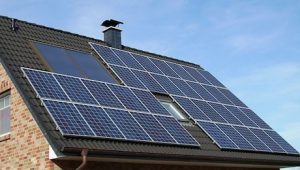Washington Electric Co-op has announced that electric rates will rise this year at 3.72 percent if the Public Utility Commission approves its request.
Like other Vermont utility rate hikes in recent years, the main culprits include grid upgrades, curtailment of large energy projects and the spread of net metering projects. The prior rate increase for Washington Electric was requested a year and a half ago.
General Manager Patty Richards told True North that they take the increases very seriously and in recent years have typically remained within 2 percent per year, within the rate of inflation.

Washington Electric Co-op General Manager Patty Richards
One of the big reasons for the rate increase is transmission expenses, Richard said. Vermont Electric Power Company, ISO New England and Green Mountain Power have been performing infrastructure upgrades, and those costs are ultimately spread across the state.
“So if you think of all the big lines that move power across the state … the combination of those three systems are the biggest driver of our rate increase,” she said. “There’s cost pressure within those organizations and those costs get transferred on to us.”
Two power sources which have been curtailed during certain periods of high production are a methane-energy plant at the landfill in Coventry and the Sheffield Wind turbine project. Richards cites these curtailments — which occur when more energy is being produced than is demanded or able to fit on the grid — as another negative impact on rates.
She also said that an increase in pressure from net metering projects is driving up rates. Net metering is when a business or homeowner purchases and installs an energy project — often solar panels on a roof — and the excess energy is sold back to the utility.
The challenge with net metering is that utilities are forced to buy the power for a high price.
“Roughly 400 of our members are net metering right now and we have to pay for generation created by those net metering systems,” Richards said. “We pay roughly 19 cents a kilowatt-hour currently. And they offset revenue at roughly 20 cents per kilowatt-hour.”
According to estimates by Vermont Electric’s manager of member relations, Andrea Cohen, typical non-net metering renewable energy usually costs around 11-to-12 cents per kilowatt-hour. And typical market rate energy, which is a culmination of all available forms of energy, varies depending on the time of year and time of day. But it fluctuates in the 5-to-7 cents range.
“If you are committed as a state to buying renewable energy, it’s important to ask how are we going to do it in the least expensive way,” Cohen said.

With net metering projects, Vermont utilities currently lose about 10 cents per kilowatt-hour on every kilowatt-hour.
Richards said the utility does have some reduced charges from the grid operators, but overall they lose roughly 10 cents a kilowatt-hour on every kilowatt-hour from a net metering system. She emphasized that Washington Electric still supports solar and the net metering program, just not at its current costs.
“It’s just the rates that are paid that are out of line,” she said. “What’s it’s causing is rate pressure and increased expense to the utilities. And we can’t offset that, so it translates into a rate increase.”
Ben Luce, associate professor of natural sciences for Lyndon State College, is a green energy advocate, but he cautions that it must be implemented with thoughtful policy. On the net metering pressures on ratepayers, he said there are a number of factors at play.
“The utility is not taking in as much money for revenue because of the net metering arrangement, and yet they still have to provide those houses with backup power for night time and cloudy days, and any costs associated with doing that has to be borne by the rest of the rate base,” he said.
He said regular industrial-scale solar also takes its toll on the ratepayers.
“It’s my strong opinion that ridgeline wind power was not appropriate for Vermont for environmental, social and economic reasons. And that has tied up a lot of the free capacity on the grid and has incurred some significant costs to ratepayers.”
Luce said a key technology development which could result in lower energy costs — especially from intermittent renewable generation — is battery technology. He said as batteries come down in price they could become less expensive than convention grid upgrades, and rather than curtail solar or wind power and waste that potential energy, it could be stored for times of greater need.
“I’ve been arguing for over a decade to anyone who would listen that we need to be looking very carefully at the storage end of things,” he said. “Because if the Utility Commission is going to justify having ratepayers pay for renewables, then we need to be looking at maximizing the economic benefits of that.”
Michael Bielawski is a reporter for True North Reports. Send him news tips at bielawski82@yahoo.com and follow him on Twitter @TrueNorthMikeB.



Golly, I thought ‘free’ renewable energy was going to be the cat’s pajamas for generations to come. Don’t tell me it isn’t going to happen. 50 years ago, when I worked in the design phase of nuclear energy, we never anticipated the shutting down of these cheap and safe plants because someone was afraid they’d blow up.
# of people killed by nuc plants in the US . . . 0.
# of people killed in Ted Kennedy’s car . . . .
So which is safer?
CHENRY,
100% RE aficionados claim wind and solar, and hydro + bio + waste, and energy storage, and demand management, and energy efficiency, and heat pumps and the batteries of electric vehicles will provide electricity, 24/7/365, at a minimum of 99.97% reliability, plus their envisioned system will be “distributed” everywhere, and it will have LOWER electricity costs per kWh, because “it does not use fuel”.
Whereas I have been warning higher rates would happen, legislators, etc., laughed at me.
Now Vermonters are FINALLY beginning to learn that the 100% RE siren song and dance is a load of bull manure.
NOTE: If 100% RE aficionados were correct, why do countries in the EU, with high levels of RE, also have high household electric rates? The commercial/industrial rates are kept low and much less burdened with taxes, fees and surcharges, for competitive reasons. Why would that be different in New England? See graph in euanmearns URL.
http://euanmearns.com/an-update-on-the-energiewende/
http://www.windtaskforce.org/profiles/blogs/wind-and-solar-hype-versus-reality
“Richards said the utility does have some reduced charges from the grid operators, but overall they lose roughly 10 cents a kilowatt-hour on every kilowatt-hour from a net metering system. She emphasized that Washington Electric still supports solar and the net metering program, just not at its current costs.”
The utility “does not lose”.
The utility rolls ALL of its costs into the rate base, including any payments paid to owners.
The utility also adds a program management fee, as set by PUC.
As a result, the net metered program has a cost of 19 c/kWh (paid to owner, AS MANDATED BY THE STATE) + 2.813 c/kWh (fee, as set by PUC) = 21.813 c/kWh; this is the same cost as of GMP.
That 19 c/kWh for residential roof top in Vermont corresponds to 12.2 eurocent/kWh paid in Germany.
Why is Vermont residential roof top so much higher?
http://www.windtaskforce.org/profiles/blogs/wind-and-solar-hype-versus-reality
The cost of batteries has decreased, but to use them to store midday solar for use in the evening is prohibitively expensive with Tesla Powerwall 2.0 units that cost about $8000, turnkey, and would deliver at most 13 kWh AC.
They would be empty throughout the night and then get charged again by solar, IF IT IS NOT OVERCAST and IF PANELS ARE NOT COVERED BY SNOW AND ICE. Such recharging would be much easier in summer than in winter.
Plus the battery would only last 10 years.
Utility-Scale Battery Pack Systems:
The turnkey project costs of utility-scale, custom-built, stationary battery systems inserted into an electric grid, likely would be at least $400/kWh, because of much lower order volumes and field conditions. These battery systems are charged with AC from the grid and deliver AC to the grid.
The installed cost of the Australian Powerpack system was about $50 million, or 50 million/129,000 = $388/kWh; this is a low price, because Tesla was eager to get the contract. The system battery is paired with French-owned 315 MW Hornsdale Wind Farm. It will help balance the South Australian grid, as well as provide about 60 minutes of emergency power for 30,000 homes in the event of a blackout.
Battery Round-Trip Losses: Battery-based electricity storage has about a 20% loss, on an AC-to-AC basis. Connecting all that distributed storage, and O&M, and replacements have losses as well. The more wind and solar on the grid, the more electricity will pass through storage, the greater the losses. RE aficionados say, just overbuild wind and solar some more to offset the storage losses
So let’s see, we have ruined our ridgelines with wind turbines and have turned our pristine
pastures to a see of solar panels …………..so now what !!
And no one thought that our power grid wasn’t going to be capable of handling all this new
energy …….Oh yeah another Liberal Boondoggle, but don’t worry they had it covered just
increase the rates……year after year !!
See it works